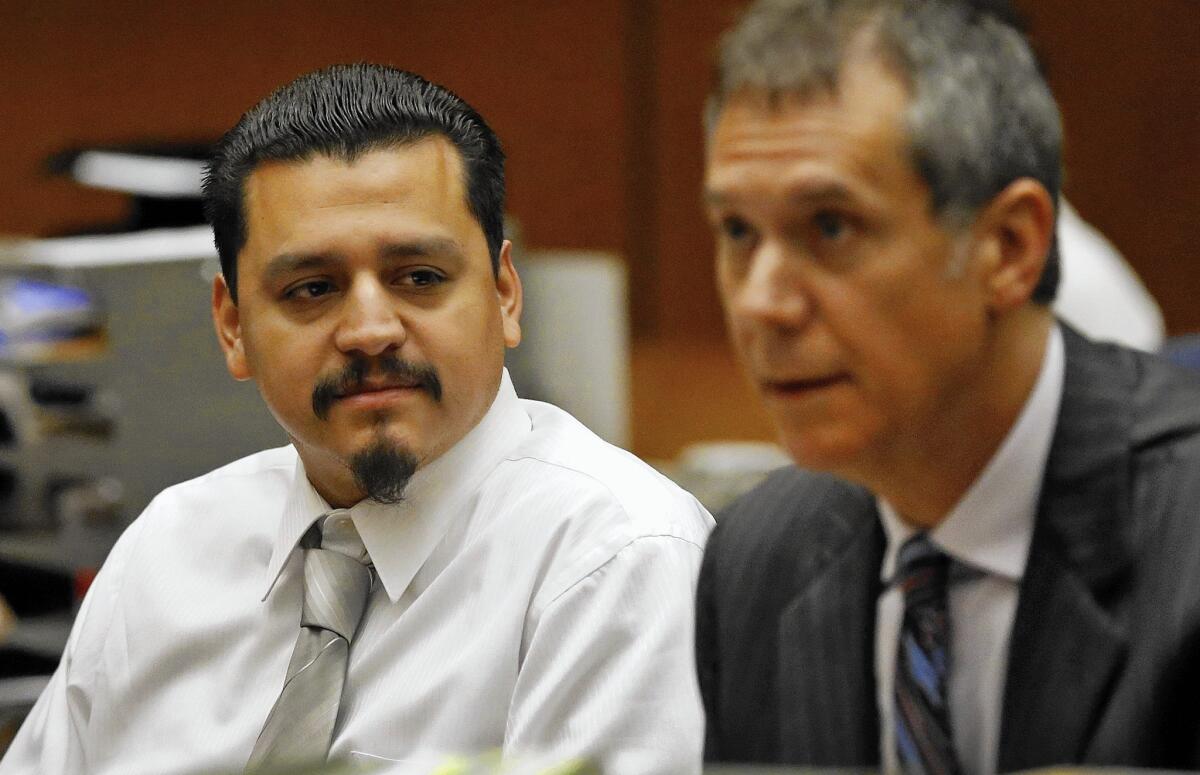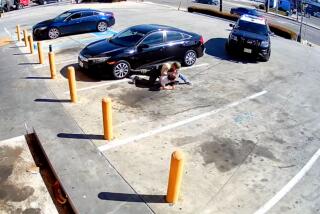Feds did what the L.A. prosecutors didn’t do: bring deputies in jail visitor’s beating to justice

The Los Angeles County Sheriff’s Department already was engulfed in a jail brutality scandal when a prosecutor in the district attorney’s office examined the beating of Gabriel Carrillo.
During a visit to the county’s main jail in February 2011, Carrillo had been left badly bloodied and bruised by a group of deputies, who broke his nose and pepper sprayed him in the face. The deputies claimed Carrillo had attacked them; Carrillo denied that and insisted he had been handcuffed during the beating.
The county prosecutor rejected Carrillo’s account.
“There is no evidence to suggest that the deputies acted inappropriately,” the prosecutor wrote in a 2012 internal memo that rejected filing charges against the deputies.
It took an investigation by federal officials to prove the district attorney’s office wrong.
This year, prosecutors from the U.S. Attorney’s Office secured criminal convictions against five of the deputies, including two who admitted in court that they participated in an assault on Carrillo while he was handcuffed. Three have been given prison terms; two more are expected to be sentenced next month.
District attorney’s officials defend their office’s handling of the case, saying their review was hamstrung because Carrillo would not speak with investigators about the beating.
But Carrillo and his attorney accuse the office of discounting evidence of wrongdoing that proved key to the federal prosecution.
Advocates for inmates rights say the case shows that the district attorney’s office has not been aggressive enough at holding deputies accountable for abuses in county jails at a time when federal authorities and a blue-ribbon panel found evidence of persistent brutality.
Join the conversation on Facebook >>
“The D.A. is supposed to be a check on illegal behavior by law enforcement. In the jails, we have a very real example of its complete failure,” said Peter Eliasberg, legal director of the American Civil Liberties Union of Southern California, the court-ordered monitor in the jails.
Although accusations of abuse of inmates have dogged the Sheriff’s Department for years, prosecutions of deputies for excessive force in the jails have been rare. In the decade before 2011, when the FBI’s investigation into alleged abuses in the jails became public, the district attorney’s office filed only two cases involving inmate beatings. Since then, the office has reviewed scores of abuse claims and filed three cases, district attorney’s records show.
Jackie Lacey, the current district attorney, who held a top post in the office when the decision to clear the deputies in the Carrillo case was made, declined requests to be interviewed or to respond to written questions submitted by The Times.
A spokeswoman said Lacey believes her prosecutors rigorously examine allegations of criminal conduct by law enforcement officers and is confident they make impartial decisions.
In the last two years, federal prosecutors have charged 10 deputies in three separate cases with crimes stemming from alleged assaults on inmates or jail visitors. The first of the cases to go to trial centered on the beating of Carrillo.
That incident began when Carrillo went to Men’s Central Jail, the largest facility in the county’s network of lockups, to visit his brother, an inmate.
When Carrillo and his then-girlfriend were found carrying cellphones in the lobby of the jail visiting center — a violation of state law — they were handcuffed and taken into a private room, court records show.
Carrillo exchanged words with a deputy, who radioed for backup, according to court testimony. Another deputy threw Carrillo to the floor and others joined in, kicking and punching Carrillo as they pinned him to the ground. One deputy delivered a blast of pepper-spray on his badly cut face. Carrillo suffered a broken nose, bruises and cuts.
In their written reports on the incident, the deputies and their supervisor maintained that they used force because Carrillo attacked them in a bid to escape when one of his hands was uncuffed for fingerprinting.
NEWSLETTER: Get the day’s top headlines from Times Editor Davan Maharaj >>
The district attorney’s office charged Carrillo with battery on a peace officer, escape from arrest and other crimes, which carried a possible 14-year prison sentence. At the preliminary hearing a few months later, Carrillo was ordered to stand trial after three of the deputies testified that he had been the aggressor.
After the hearing, Carrillo retained a new attorney, Ron Kaye, who was struck by photographs taken by his client’s girlfriend a few days after the arrest. They showed red, aggravated lines encircling both of Carrillo’s wrists — proof, Kaye believed, that Carrillo was handcuffed throughout the incident.
Kaye said he showed the photos, along with medical records that documented the wrist injuries, to the prosecutor in the case and her supervisor. Days later, Deputy Dist. Atty. Kathy Ta announced at a court hearing that she was dropping the case against Carrillo. She gave no explanation for the move other than to say it was “in the interest of justice” and left open the possibility that she would refile the charges against Carrillo in the future.
By this time, investigators from a special unit in the Sheriff’s Department were looking into Carrillo’s arrest and tried unsuccessfully to speak with him.
Kaye said he would never have allowed sheriff’s investigators to interview Carrillo. With a possible prosecution still hanging over his client, any perceived inconsistencies in Carrillo’s statements could have been used against him, the lawyer said. “His freedom was at stake,” Kaye said.
The sheriff’s investigators did uncover text messages the deputies’ supervisor, Sgt. Eric Gonzalez, sent to a deputy who had been involved in the arrest of Carrillo’s brother. The brother had also been injured by deputies during his arrest.
Gonzalez sent a photo of Carrillo’s bloodied, swollen face and wrote, “Looks like we did a better job. Where’s my beer big homie.”
The sheriff’s investigators handed over their findings to Fernando Guzman, a lawyer in the district attorney’s Justice System Integrity Division, which reviews allegations of criminal behavior by law enforcement officers.
In his memo about the case, Guzman gave an account of Carrillo’s arrest that followed the deputies’ version of events and quoted civilian witnesses who said Carrillo had acted in a confrontational way with the deputies. The memo, which was reviewed by the Times, made no mention of Gonzalez’s text messages, the medical records and photographs of Carrillo’s wrists, or the allegations of abuse and a cover-up that Kaye had made to district attorney’s officials, as well as in a lawsuit and news articles.
Guzman’s memo did point out that the criminal case against Carrillo had been dismissed “pending ongoing investigations of the deputies’ actions,” but then concluded that the force the deputies used “appeared to be reasonably necessary to subdue Carrillo, who assaulted three deputies and was attempting to escape.”
For his part, Kaye contends that the district attorney’s office “took the word of these deputies as gospel, regardless of how much we presented evidence of the likelihood they were lying.”
Guzman, who is no longer assigned to the Justice System Integrity Division, did not respond to requests for comment. James Garrison, who took charge of the division after the case was decided, said in an interview that he had done a thorough review of the case and “did not find anything that would lead me to believe mistakes were made.”
Garrison acknowledged that Guzman had seen the photographs of Carrillo’s wrists, but he said without a direct statement from Carrillo it was impossible to know how the wrist injuries were caused. For a prosecution of the deputies, the district attorney’s office needed more than just a statement from Carrillo’s attorney, he added.
Second-guessing Guzman’s conclusion in light of the decision by federal prosecutors to go after the deputies is unfair, Garrison said, because Carrillo cooperated with the U.S. Attorney’s Office.
Lizabeth Rhodes, one of the assistant U.S. attorneys who prosecuted the deputies and Gonzalez, said it was an easy decision to step in.
“Sometimes it’s better to bring a case and risk losing than not bringing the case at all,” she said. “If you don’t bring it, then you’ve already lost.”
Federal prosecutors went to a grand jury, which indicted Gonzalez and four other deputies on civil rights violations. Two deputies eventually pleaded guilty to lesser charges in deals with prosecutors and testified against the others, saying that Carrillo had been handcuffed throughout the beating and then framed.
Jurors who convicted the deputies of using excessive force and conspiring to violate Carrillo’s civil rights said afterward that they were convinced, in part, by the photographs of Carrillo’s injured wrists – the same photos that Carrillo’s attorney had given to the district attorney’s office.
The two deputies and Gonzalez were sentenced to between six and eight years in prison.
Carrillo returned last month to the downtown courtroom where he had listened to the deputies testify against him nearly five years earlier and asked a judge to formally erase the case from his record.
Ta told the judge her office had no objection to clearing his name. The judge granted the request.
After the hearing, Carrillo reflected on his ordeal.
“There is a lot of blame to go around for a lot of people. It starts at the top all the way down to the bottom,” he said. “If the D.A. was doing their job right…I’m sure they would have found the truth.”
Twitter: @joelrubin
ALSO
Even for the active, a long sit shortens life and erodes health
Thanks to Good Samaritans, homeless vet was lost but not forgotten
How the U.S. burned $231 million on a program that never should have left the drawing board
More to Read
Sign up for Essential California
The most important California stories and recommendations in your inbox every morning.
You may occasionally receive promotional content from the Los Angeles Times.











